How to Build an Email List with WordPress
Quality leads are the lifeblood of your business. Without leads, you’ll struggle to get the customers you need to turn a profit. You can pay for leads through advertising, but what if we tell you that your ideal customer is willing to give their personal information for just your knowledge or a small discount in return? It is easily done through one of the most powerful, and most neglected, lead generation methods available today.
We’re talking about email marketing.
There are several ways to capture leads; you can offer a lead magnet, use social media platforms like Facebook and LinkedIn, or pay for Google Ads. But, by far and away the most effective way to get more customers is by building your email list.
According to this research by Statista, by 2023, more than half of the world’s population is going to be using email – that’s over 4.3 billion people around the globe that you can reach with your newsletters. At the time of writing this article, we’re halfway through 2021 and nearly 9 out of 10 content marketers use email to distribute content. So, if you’re not one of them, you’re falling behind!
Whether your business is plateauing or you are simply looking for an effective lead generation channel, building an email list with WordPress is a fantastic way to expand your brand awareness, increase revenue, and grow your business.
What Is An Email List?
An email list is simply a list of emails that businesses have gathered from their website visitors, customers, and even in-store shoppers that have indicated an interest in receiving updates from that company via email. Businesses capture emails through a variety of different ways:
- Using lead magnets (like discount codes)
- Check-boxes on payment pages
- Running Facebook Ads
- Live events (or virtual summits)
- Reaching out to people individually
You can also buy email lists from third-party marketing firms, though that’s not recommended. The people that these email addresses belong to, don’t know you. They most likely opted-in for another brands’ newsletter, contest, giveaway, or another incentive, so they expect emails from those brands. They didn’t sign up for your newsletter and will receive your e-mail as unsolicited and/or will just unsubscribe right away. Besides that, you don’t know how often an email list has been sold before you got your hands on it, if the list is GDPR compliant, and/or if the list contains spam traps. Watch out and don’t get a spammer reputation.
The best email lists are the ones which you create on your own by engaging visitors on your website and social media and by providing valuable content.
The Benefits of Building an Email List
Building an email list should be a no-brainer for any business that has an online presence. It’s the ultimate way to engage with your audience and trigger any potential customers into making a purchase.
Here are just a few benefits of having an amazing email list.
Email Helps You Grow Your Business
There’s little doubt in the fact that email, when done right, outperforms all other marketing strategies. According to a survey done by McKinsey and Company, email is 40 times more effective than both Twitter and Facebook combined for customer acquisition. The people in your list signed up for your newsletter, they WANT to hear (and buy) from you. Your focus should be on this highly interested group of customers to efficiently grow your sales.

Source: Why marketers should keep sending you e-mails
Instead of spending hours a day trying to write tweets, make attractive graphics, and run giveaways on Facebook, you can craft a powerful email and send it directly to people that want to buy from you.
Emails Are Personal
When you send an email to a person, it ends up in their inbox, not just a timeline they scroll down on. You send a message specifically to them, so be personal. Start with their name (most email automation plugins allow you to craft custom emails), trigger their curiosity in the subject line, and moreover, offer content that is of value to them.
By crafting a personal touch to your emails, you strengthen the relationship with your customer. You can make them feel special, connected, and understood. You probably send them content that they are interested in, so the more they feel connected to your brand, the more likely it is that they buy from you.
Subscribers can also reply to your emails, which ultimately leads to a more intimate relationship with your audience. It makes the average user feel special when they get a response, and a satisfied customer might even go on to recommend you to others!
Email Marketing Has A Fantastic Return on Investment
The average return on investment on email marketing is $42 for every $1 you spend. More importantly, when compared with direct mail and social media marketing, email has the highest conversion rate – an estimated 66%. Do we need to say more?
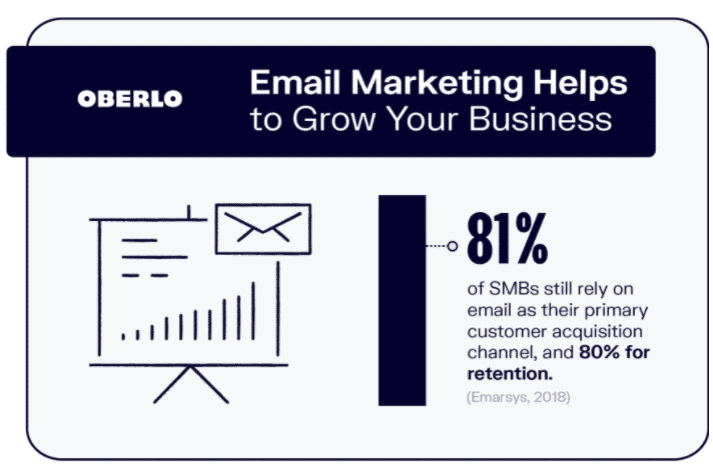
Source: 10 Email Marketing Statistics You Need to Know in 2021
If you want to spend money on multiple lead generation channels, a large chunk of your marketing budget should be dedicated to email marketing.
Ideal for Measuring Content Performance
How is your content performing? Is it having the right impact on your viewers?
Email marketing gives you an excellent insight into whether your most interested customers like your content or not, and you can tailor your content strategy based on the response. Email is the third-largest content distribution channel used by B2B marketers, according to Content Marketing Institute, and if your content happens to hit the exact pain point your customer is facing, it has a much higher chance of converting.
Overall email engagement and subscriber numbers also play an important role in determining how your content is doing:
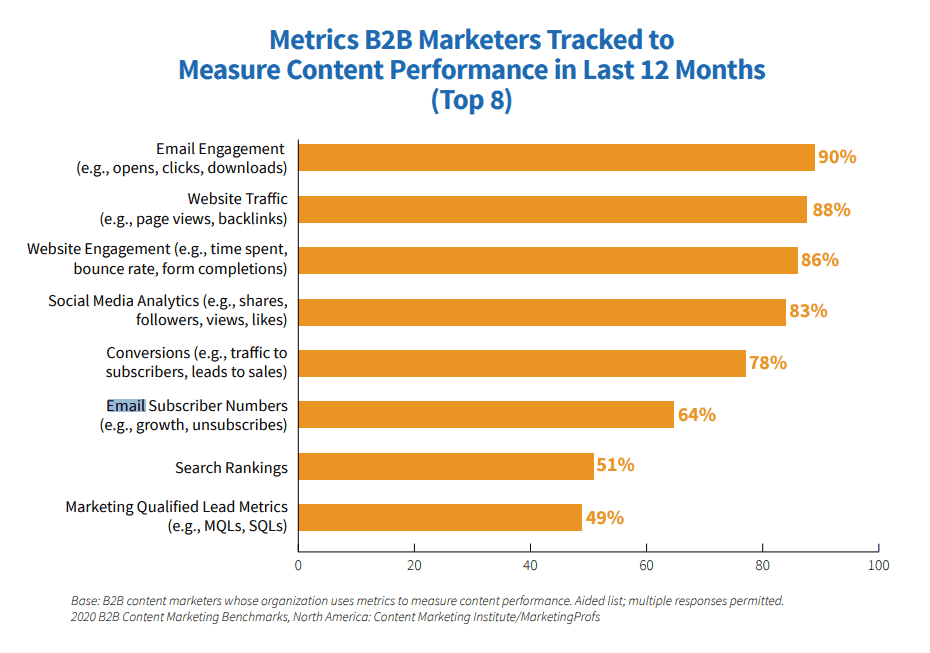
Source: Benchmarks, Budgets, and Trends—North America
So now you’ve learnt about why having an email list is so important, it’s time to dive into how you can build one.
Capturing Emails on WordPress: The Complete Guide
WordPress is the world’s most popular content management system, used by millions of websites around the globe. From big corporate organizations to small business owners. So if you want to capture emails on your WordPress site, you don’t need to worry about having any kind of technical knowledge.
There are just a few essentials you’ll need to get started:
- A WordPress-powered website
- An email automation plugin like MailOptin
- An email marketing service like MailChimp or Kit (ConvertKit) (optional)
If you are already using WordPress for your website, you need to first install the MailOptin plugin.
How to Install the MailOptin Plugin
MailOptin is a comprehensive WordPress plugin guaranteed to generate high-quality leads, increase user registrations, and boost conversions. It simplifies list building and offers a cohesive lead capturing system for your WordPress site. It also integrates seamlessly with other popular services such as MailChimp, AWeber, Kit (ConvertKit), Campaign Monitor, Email Octopus, and many others. Check all integrations here.
It’s a handy plugin that’s ideal for everyone who want to leverage the power of email marketing, and only takes a minute to install.
Step 1: Log into your WordPress Dashboard
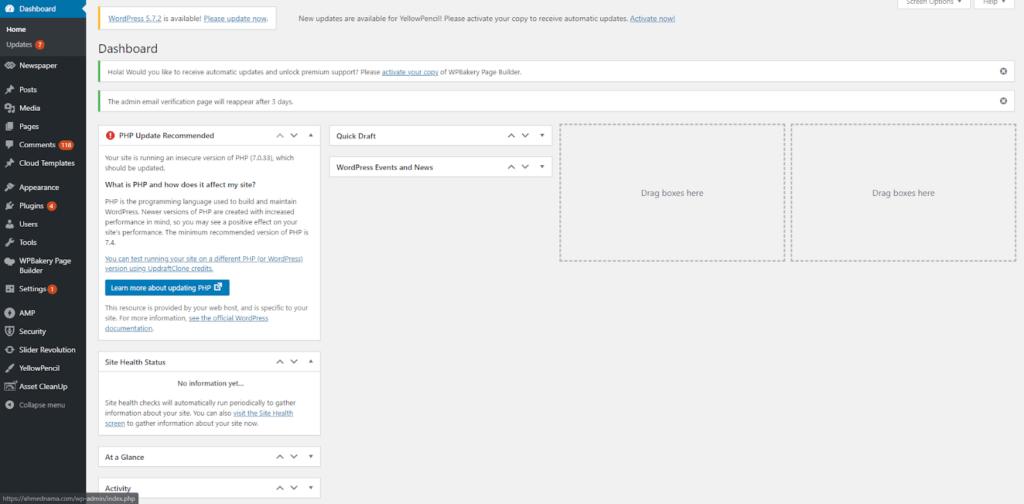
This is what you’re going to see when you log into your WordPress backend. Now, you need to find Plugins on the left pane in the navigation menu. As you can see, it’s right below Appearance.
Step 2: Add a New Plugin
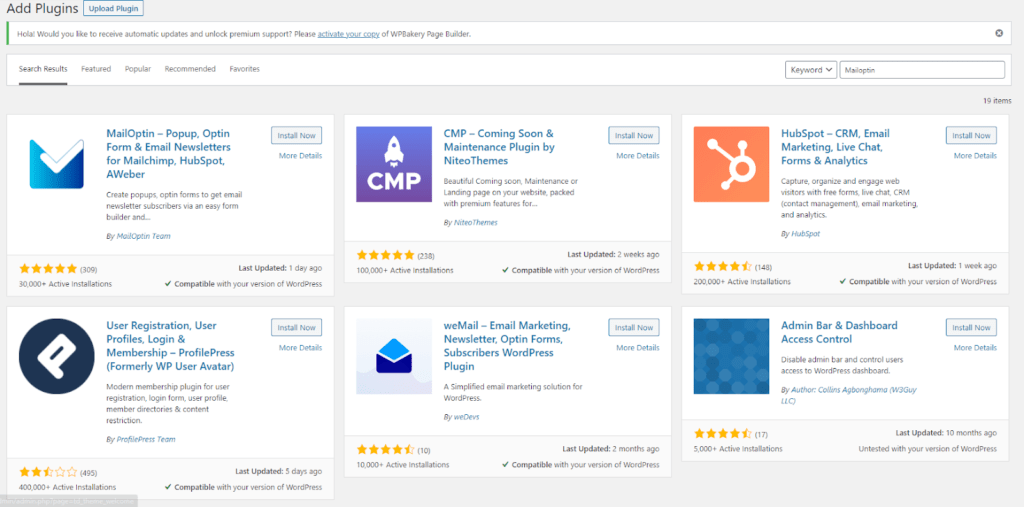
When you hover your cursor over Plugins, it’ll show you two options: Installed Plugins and Add New. Click on the latter. Search for MailOptin in the search bar located on the top right. Then, just click on Install Now to start the installation.
Step 3: Activate the Plugin

To gain full functionality, you need to activate the plugin. Just click on Activate, and you are good to go.
For premium users:
You also need to activate the license key in order to receive full access to MailOptin the plugin. To activate the license, go into the settings for the plugin, and select License. A premium license is optional.
Enter the license key you received when you purchased it, click on Save Changes, and that’s it; you now have installed MailOptin on your WordPress site.
Set Up An Email Capture Form
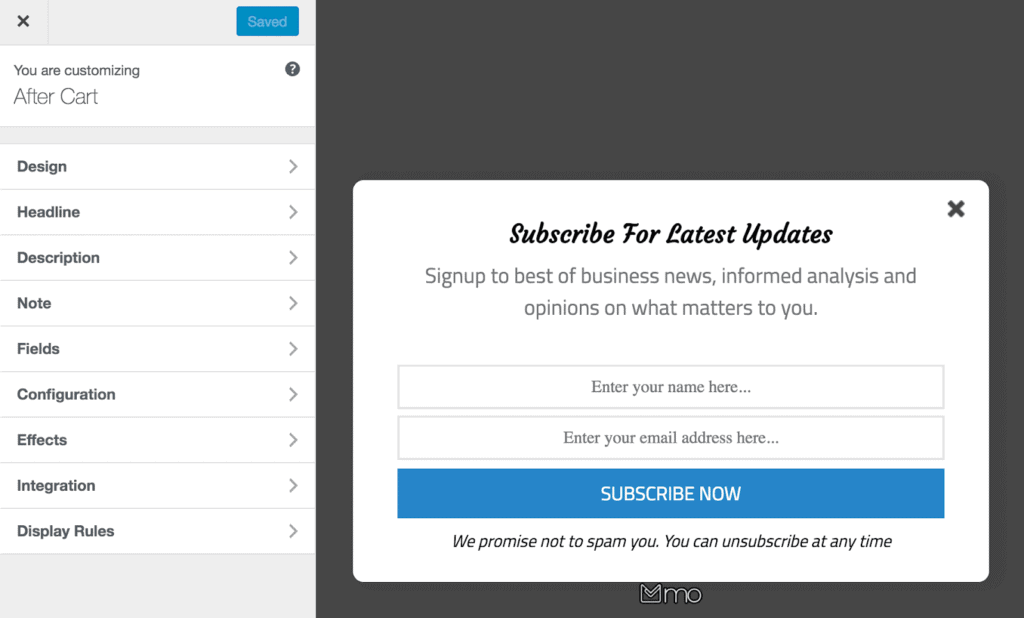
Before you can get started, you need to create an email capture form for your website. If you are going to offer a lead magnet in return for your visitors’ contact details, you should design a form that attracts the viewer’s attention. MailOptin has an array of features that you can use to build a captivating form.
There are plenty of pre-designed templates, each of which you can customize according to your liking. It’s important that you use a few attention-grabbing elements like contrasting colors, a nice font, and great copy.
Once you customize and create the form, you should fill it out and send some test emails to make sure it’s working. Once you have the lead generation form set up, the next step is to create an email campaign to nudge subscribers forward in your sales funnel.
Creating Your First Email Campaign In MailOptin

Source: Email Automation & Newsletter Solution for WordPress
MailOptin has an intuitive email builder that you can use to create custom email templates. When creating your email campaign, make sure you use both text and images to improve readability.
An important thing to consider is the subject line. According to SuperOffice, 45% of your subscribers will read your emails because they know who it’s from (sender), but 33% of your recipients will open an email due to the subject line alone.
So, what makes a great subject line? Keep it short, captivating, and personal. For more info, read our guide on improving email open rates.
How Often Should You Send Emails to Your List?
Ideally, you should send between one and two emails per week. That’s the sweet spot, according to one study.
However, you need to figure out the optimal frequency for sending emails to your list based on needs, products, and customer type. Make sure it’s predictable, and schedule your emails accordingly. It’ll give your audience something to look forward to.
Bombarding your subscribers with emails every day is a terrible idea for several reasons:
- You won’t have any valuable content left to share.
- Your subscribers will get annoyed.
- Your subscribers can’t keep up with all info you send to them
- Your emails will end up in spam folders.
The main reason why people unsubscribe from email lists is because they receive too many emails from one sender.
Be mindful of your audience, treasure your list. If you’re going to increase the sending frequency, keep a close eye on the click-through rate (CTR) and email open rates (OR). See how your audience responds and adapt your strategy accordingly.
How to Create a Captivating Lead Generation Offer
What will a customer get in exchange for their contact details? A lead generation offer needs to be captivating and intriguing enough that a reader is willing to give their contact details. Depending upon your niche, you could choose to provide a few different lead generation offers, a.k.a. lead magnets.
Ideally, a good lead magnet should:
- Provide high value
- Highlight your unique selling point
- Offer instant gratification to the lead
There are several interesting lead magnets that you can use, such as:
Training Videos
Training videos are commonly used in the education industry. They help you offer something of value right away to your customers and hook them in for more. Like, “if you want to know more about this subject, sign up here, and receive the next knowledge bomb in your inbox”.
Free Templates
Businesses can offer templates for different kinds of proposals as a lead magnet. From web development proposals to email templates to client contracts, anything could be served up.
Case Studies
A genuinely interested visitor might sign up for a case study in order to get deeper insights into how you dealt with customers in specific scenarios, especially if they run a similar business. More than 63% of marketers believe this to be a fantastic marketing strategy.
Discount Codes
Arguably the most effective lead generation offer for e-commerce sites. You can provide a discount code to customers in exchange for their email address.
Five Simple Strategies for Growing Your Email List
By now, you know all about building an email list on your WordPress site. But you need to constantly work in order to grow your list. Here are three strategies that can help to capture readers, cultivate a following, and convert customers:
1. Use Twitter to Your Advantage
The rise of “short content” has been hard to ignore over the past few years. Despite the fact that long-form content dominates Google, more and more people prefer getting their information from sites like Twitter. Use that to your advantage.
Create a thread offering interesting insights and information to your followers. At the end of a thread, post a link to your newsletter or your lead magnet, and ask them to sign up. If you are able to provide consistent value for free on sites like Twitter, people will be keen to know what value your newsletter or email list has to offer.
2. Promote Content on Social Media
Used by brands all over the globe, this is a time-tested strategy for growing your email list. Offer a free giveaway to your followers on platforms like Facebook or Twitter in exchange for their contact details. Ask them to share and tag others in the posts as well.
Giveaways usually result in large numbers of people signing up, however, the type of people that take part probably won’t become paying customers in the future. They signed up to win something, not to buy something. Try not to overdo this, because it could eventually bloat your list and make it extremely low quality.
3. Leverage Online Events
If you appear in a webinar or join a podcast as a guest, use that added exposure to your advantage. Let viewers or listeners know about your website and encourage them to sign up for your email list. Of course, your pitch on the chosen platform should be appealing to listeners if you want more people to sign up in the first place.
4. Guest Posting
Guest blogging is a smart way to increase your email list. Start by creating a shortlist of influential blogs that already have a dedicated following within your industry.
Many blogs offer guest posting opportunities, so you can pitch your content idea to them via mail or through a form on their website. The most important part of guest posting is to pitch a dazzling content idea that’s guaranteed to grab their attention.
Remember, the blog’s audience could potentially turn into your future audience. Give them a reason to sign up to your list.
Your content should be actionable. Add CTAs to get more people to sign up to your list, and add a link to a landing page with a sign-up form of your email list.
It’s an intuitive way to offer something more to users who liked your piece.
5. Use Targeted Pop Ups
A targeted pop-up is shown to a segmented audience and is usually triggered based on user behavior, like clicking on a button, exit intent, or scrolling 50% down a page. MailOptin allows you to create targeted pop-ups that you can use to grow your email list.
Entice your audience with a relevant offer on exit intent, or speak directly to them by using the referral source that brought them to your site. Use similar images and create an interesting headline that matches the source.
For instance, if you offer a “15% off on first order” in an Instagram ad, make sure your popup repeats the same. You can also reference the source in the popup: if a person landed on your page through Instagram, offer a coupon code like INSTAFAM15 for anyone that’s about to click off the site.
Conclusion – MailOptin Makes Building Your Email List Easier Than Ever
Building an email list through your WordPress site is incredibly easy, especially with a plugin like MailOptin. Of course, it requires constant testing and optimization, because you’ll need to find out what works and what doesn’t so that you can maximize conversions.
If you want to start building your list or take your current one to the next level, consider trying out MailOptin today.
